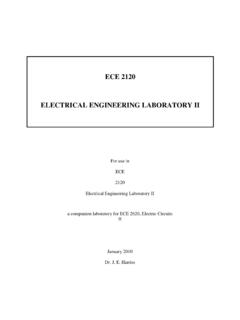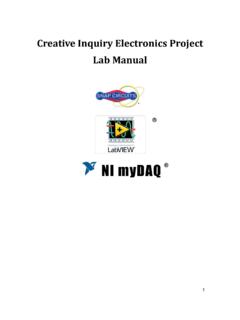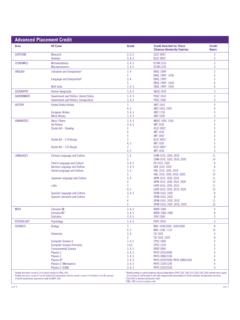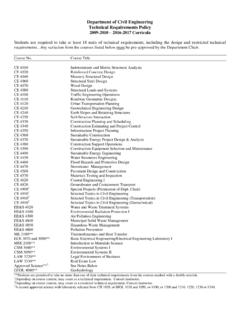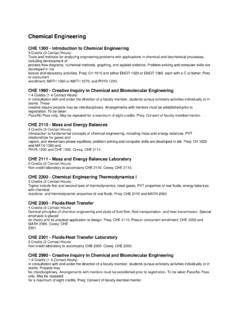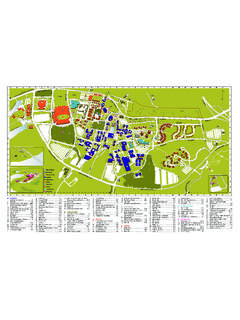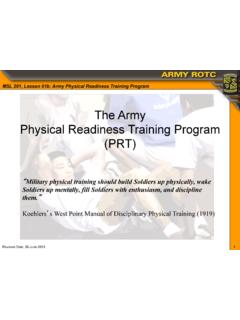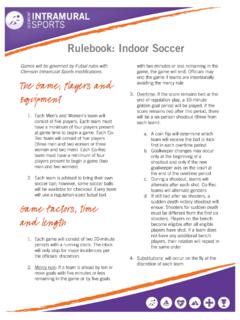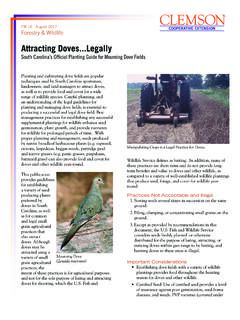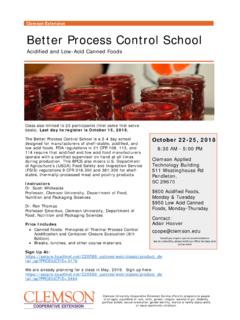Transcription of ELECTRICAL ENGINEERING LABORATORY I
1 ECE 2080 ELECTRICAL ENGINEERING LABORATORY I by A. L. Duke Dan McAuliff CLEMSON UNIVERSITY Revised January 1998 by Michael Hannan Revision : May 2015 by Amir A. Asif ECE 309 2015 ii Revision Notes 1991 Authors: A. L. Duke and Dan McAuliff. Original release. 1998 Author: Michael Hannan. Reorganization, mostly with same information. 2008 Author: James Harriss. General reorganization, corrections, and update. Clarified instructions to reduce equipment damage and blown fuses. Redrew many figures. Rewrote LABORATORY sessions on SPICE and Oscilloscope. Added equipment list and references. Created common Appendix (A to E) for ECE 309 and ECE 212. Moved Safety and Oscilloscope background information into Appendix. Added appendix for Tektronix TDS 1002B Oscilloscope. August 2008. 2010 Author: Dr. J. E. Harriss. In Lab 5 - Oscilloscope: Add explanation of RMS and clarify purpose of the experiment; delete procedure 5, Lissajous figures.
2 May 2010. 2015 Author: Asif Amir. Simulation lab rewritten. Appendix F added. Re-arranging the order of labs to keep pace with the co-requisite course. Alternate method added in instrument (voltmeter) characterization. Pre-lab and post-lab redefined in circuit analysis chapter. ECE 309 2015 iii Table of Contents Revision Notes .. ii Table of Contents .. iii Equipment .. iv References .. v vi Introduction .. vii Preparing the LABORATORY Notebook .. viii Reports .. x LABORATORY #1: Course Description and Introduction .. 1 LABORATORY #2: Measurement of DC Voltage and Current .. 2 LABORATORY #3: Computer Analysis .. 4 LABORATORY #4: Instrument Characteristics .. 7 LABORATORY #5: Problems: circuit Analysis Methods .. 13 LABORATORY #6: Network Theorems .. 17 LABORATORY #8: Oscilloscope .. 22 LABORATORY #9: Problems: AC Power Calculations .. 25 LABORATORY #10: AC Measurements.
3 26 LABORATORY #11: Problems: Operational Amplifiers and Digital Logic .. 28 LABORATORY #12: Digital Logic Circuits .. 29 Appendix A Safety .. 31 Appendix B Equipment and Instrument 36 Appendix C Data Plots .. 49 Appendix D Operating Instructions for a Typical Oscilloscope .. 51 Appendix E Tektronix TDS 1002B Oscilloscope .. 57 Appendix F Simulation Tool: PartSim .. 63 ECE 309 2015 iv Equipment Description Manufacturer Model AC Power Supply ..use Autotransformer or Transformer Board Ammeter-Voltmeter, Analog ..Hampden ACVA-100 Autotransformer (Variac) ..Powerstat 3PN116C Capacitance Decade Box ..EICO 1180 Capacitor, 40 D PFC2001C DC Power Supply ..TENMA 72-7245 Digital Designer ..Digi-Designer DD-1 Frequency Counter ..Tektronix CFC250 Function Generator ..BK Precision 4011A, 5 MHz Inductor, 10 mH ..ECE Inductor, coaxial, 36mH, 28mH, 120mH ..ECE LCR Meter ..BK Precision 878 Multimeter, Digital, True RMS.
4 Meterman BDM40 Wavetek BDM40 Oscilloscope, Dual Beam ..Tektronix TDS1002B or TDS1002 Resistance Load Resistance/Reactance Load Box ..Hampden RLC-100 Resistor Decade Box, High 240C Resistor Decade Box, Low Power ..Heathkit IN-3117 Transformer Board ..mounted 120V to & transformer Two-port Network ..ECE Voltmeter, AC3V-300 Voltmeter-Ammeter, Analog ..Hampden ACVA-100 Wattmeter, Dual Analog ..Hampden ACWM-100 ECE 309 2015 v References 1. Giorgio Rizzoni, Principles and Applications of ELECTRICAL ENGINEERING , Fifth Edition, McGraw-Hill, December 2005. 2. Giorgio Rizzoni, Principles and Applications of ELECTRICAL ENGINEERING , Revised Fourth Edition, McGraw-Hill, July 2003. 3. Mahmood Nahvi, Joseph A. Edminister, Schaum's Outline of electric Circuits, Fourth Edition, December 2002. 4. James W. Nilsson and Susan Riedel, electric Circuits, 8th Edition, Prentice Hall, May 2007.
5 5. James W. Nilsson and Susan Riedel, electric Circuits, 7th Edition, Prentice Hall, May 2004. 6. charles alexander , Matthew Sadiku, fundamentals of electric Circuits, Second Edition, McGraw-Hill, May 2004. ECE 309 2015 vi Preface This LABORATORY manual is composed of three parts. Part One provides information regarding the course requirements, recording the experimental data, and reporting the results. Part Two includes the LABORATORY experiments and problem exercises to be performed. Part Three is an appendix with sections regarding ELECTRICAL safety, general equipment in the LABORATORY , creating a logarithmic scale for graphs, general information about oscilloscope use, and specific information about the oscilloscopes available in the LABORATORY . ECE 309 2015 vii Introduction This LABORATORY course operates in co-ordination with the companion lecture course, ECE 2070, Basic ELECTRICAL ENGINEERING .
6 Each course complements the other: Several ECE 2080 exercises require knowledge of theory developed in ECE 2070, and several assist in understanding ECE 307 concepts. Preliminary LABORATORY preparation ( Pre-Lab ) is assigned for most periods. A student who understands this preliminary preparation should be able to complete the exercises during the time scheduled. Much of the value of the LABORATORY exercises lies in working with the instruments and other ELECTRICAL equipment; therefore, attendance is required. Since the LABORATORY facilities are in use almost every period of the week, it is difficult to schedule make-up periods to complete the work. If absence is unavoidable, the instructor can usually assist in arranging a meeting with another section. The instructor of each section will inform that section of policies regarding tests, ethics, the method of determining grades, and other administrative matters during the first-period orientation.
7 This LABORATORY course has five major objectives: (1) Familiarization with basic ELECTRICAL measurement techniques, (2) Enhancing ability to apply ELECTRICAL theory to practical problems, (3) Practice in recording and reporting technical information, (4) Familiarization with ELECTRICAL safety requirements, and (5) LABORATORY verification of some elementary theorems and concepts of ELECTRICAL ENGINEERING . These objectives are to be accomplished by a series of LABORATORY exercises and problem sessions. The LABORATORY exercises are generally focused on ELECTRICAL instrumentation, with one period focused on using a digital computer program to analyze ELECTRICAL networks. The problem sessions are coordinated with the theory covered in the lecture. The problem sessions involve two types of problems: (1) those that are of a more applied nature, such as application of theorems to bridge circuits, and (2) those for which the topic requires little or no lecture, such as determination of shunts and multipliers to change the scale of ammeters and voltmeters.
8 While some assigned problems are similar to those in the text, others extend the text material in order demonstrate how the theory can be applied to basic problems encountered in general ENGINEERING practice. ECE 309 2015 viii Preparing the LABORATORY Notebook LABORATORY -oriented ENGINEERING work, particularly research work, provides information that is usually quite detailed. Records of this work and the results specified are kept in LABORATORY notebooks. LABORATORY notebooks must be complete and clear, since data recorded may provide a basis for calculations, conclusions, recommendations, ENGINEERING designs, patents, etc. These notebooks are given to the engineer to generate various types of reports, sometimes after long periods of time. They may be used by others to verify the work, or as a base for additional work. They also may serve as evidence in lawsuits over patents.
9 While the format of the notebook is an individual matter, certain standards must be maintained to ensure accuracy and readability. The requirements and procedures necessary to produce a good LABORATORY notebook are given in the following paragraphs. The lead page or pages of the LABORATORY notebook should contain general information, such as title, purpose, and LABORATORY location. The information recorded in the LABORATORY notebook should be sufficiently detailed to permit the work to be duplicated at a later date by the writer or by other knowledgeable engineers. It should include all data observed and the pertinent conditions that existed, such as instruments used, parameter settings, and so on. Entries in the notebook should be in chronological order and should be in ink. Any erroneous or incorrect entries should not be erased, but should be lined through. Pages should be numbered consecutively, with no pages removed or torn out.
10 No blank pages should be left. Any pages or partial pages left blank should be lined through. Each entry should be dated and signed and, if appropriate, witnessed. Dating, signing, and witnessing are especially important when pursuing or protecting patents. Types of entries in a LABORATORY notebook include concise written explanations of procedures, equations used, freehand sketches and diagrams, tables, curves, charts, photographs, lists of apparatus, and references to items such as blueprints that are large or bulky to include. The LABORATORY notebook normally should not contain lengthy presentation theory or reference material, or extended discussions of ordinary or routine results. Written explanations should be sufficiently detailed to permit the writer to understand what was done even after several years have elapsed, but should not be burdened by trivial details.
